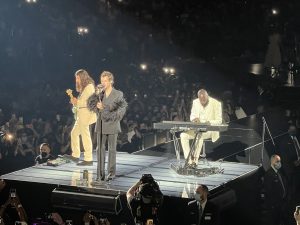
While corporate giants like Madison Square Garden dominate headlines with their astronomical prices and Ticketmaster’s endless fees, the heartbeat of live music in our tri-state area beats strongest in its small venues. These overlooked spaces offer an intimacy and raw energy that no stadium can replicate – places where you can genuinely connect with the music and the artists.
But lately, even here, at the venues that have always felt accessible, Hunter students are starting to feel priced out. When general admission at a 300-capacity club costs as much as a nosebleed seat at a major arena, we must ask ourselves: What exactly are we paying for?
Small venues have always been the lifeblood of music culture. The appeal isn’t just about who’s on stage; it’s about how close you can get to them. A show at Baby’s All Right in Brooklyn or The Bowery Ballroom in Manhattan feels less like a concert and more like a shared experience. These aren’t just buildings; they’re incubators for community, discovery, and the unadulterated soul of music.
However, that intimacy is coming at an increasingly steep price. Tickets for even regional acts regularly fall in the $30–$60 range before fees. Add service charges from third-party platforms, and suddenly, a “cheap” night out is flirting with $80, just to stand in a small room—and that’s before factoring in subway fare or an overpriced drink.
Let’s be real about these “intimate” nights. You might grab a $45 general admission ticket to see a band at a venue like Elsewhere in Bushwick, thinking you snagged a deal. Then you get there, and a single drink can set you back $15, served in a cup designed to maximize your regret. Add a band tee you impulsively buy for $40, and your “bargain” ticket quickly escalates into a $100+ lesson in budgeting. These tickets might have been $15–$25 just a decade ago, often paid at the door. This dramatic price jump directly contradicts the long-held belief that small venues are affordable for students and young music lovers.
Meanwhile, larger venues, often backed by Live Nation or AEG, offer massive production value, giant LED walls, food courts, and VIP lounges. Yet, their starting ticket prices can sometimes mirror the $60 base price you’d pay for a small-venue show.
This isn’t to say small venues are intentionally gouging us, far from it. They’re caught in the same financial pressure cooker we all are. Inflation, staffing shortages, and lingering pandemic debt are all factors. Add in artist guarantees and rising travel expenses, and you start to see the squeeze from all sides. Then there’s the controversial practice of venues taking a cut of artist merchandise sales, often anywhere from 10 to 40%.

As many Hunter students who are also aspiring artists can attest, this practice, while not new, is hitting harder than ever for touring musicians just trying to break even. As Cody Cunnius, vocalist of Long Island metalcore band Desolate Sun, put it: “We already put everything we have into getting to the venue—gas, gear, time off work. Then we find out they want 20% of our shirt money? That’s rent for some of us.” These cuts can feel like a gut punch for rising bands and local promoters just trying to stay afloat.
There’s another major culprit in this story: ticketing platforms. Services like Eventbrite, AXS, and See Tickets have adopted the same “convenience fee” structure that fans have long loathed from Ticketmaster. Suddenly, a $40 ticket becomes $58, with little explanation for why. There’s rarely any transparency—just an email confirmation and a growing sense that you’re being taken for a ride before you even set foot in the venue.
And let’s not even get started on those arena shows. Many of us have experienced sticker shock: shelling out hundreds of dollars for a single ticket only to find a portion of that cost went straight into “fees” you didn’t even know existed. It’s an experience that leaves you feeling more bewildered than thrilled.
While Governor Kathy Hochul signed legislation in June 2022 to curb some unfair ticketing practices in New York, mandating upfront disclosure of total costs and prohibiting specific fees, its impact has been minimal beyond some “all-in” transparency. This doesn’t address the deeper issues, like dynamic pricing or the continued use of bots. Ticket bots use automated software to flood presales, bypassing security measures like CAPTCHAs and buying up large quantities of tickets in seconds. These tickets are then resold at steep markups on secondary markets, leaving everyday fans priced out. It’s worth mentioning that Governor Hochul’s initiative only applies to New York State.

As Hunter students, we often visit venues outside the city or visit our favorite artists. We need more comprehensive advocacy at the federal level. The ongoing Department of Justice investigation into whether Ticketmaster and Live Nation constitute a monopoly is a start, but it’s not enough.
Students shouldn’t have to choose between supporting a night out and buying groceries. Music should be an accessible escape, not an expense requiring maxing out credit cards.
If we care about real live music, which thrives on connection and discovery, we must protect the places that nurture it. We shouldn’t romanticize the struggle of struggling artists and venues. Instead, we should demand fair pricing, transparent fees, and genuine support from local governments and fellow music lovers. The future of live performance doesn’t belong to monopolies. It belongs to us, the fans, the artists, and the vibrant small venues that make our music scene unique.

